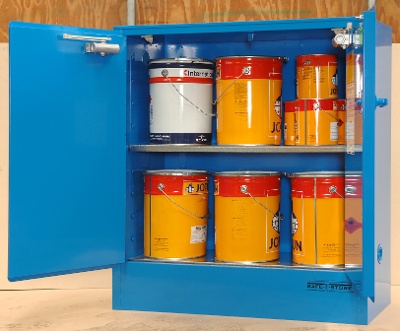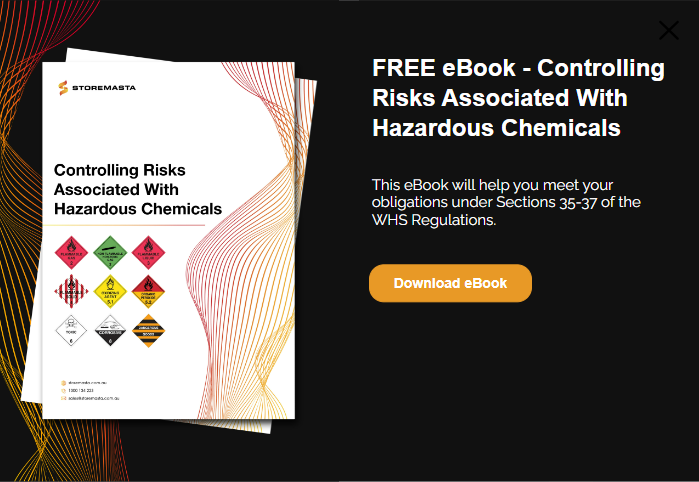Are you in the process of selecting and installing a chemical cabinet for your workplace? It can be overwhelming when looking at all the options, especially when you’re also considering the regulations and requirements for your workplace. However, this blog is designed to help you through the process, so you can tick all the boxes necessary for the safe storage of dangerous goods and hazardous chemicals.
While your chemical cabinet is constructed to reduce the many risks associated with your stored substances, there are additional considerations that can help you increase the efficiency and practicality of your chemical storage areas. So, let’s get straight into our 7 tips by highlighting the first key consideration that can fast-track your search for a smarter HAZCHEM storage solution.
1. How Will It Be Used?
While this may seem like an obvious question, safety cabinets are often more than just a storage facility for your chemicals.
There may be a variety of ways that your staff are using the cabinet, including:
- To store packages that will remain unopened
- To store packages that will be regularly opened and used
- As storage for chemicals which may require decanting, pumping or transferal
- An additional store for surplus supplies
How your staff use the cabinet, as well as how often they access the stored chemicals, can impact your decision when it comes to selecting an appropriate safety cabinet.
With upright cabinets and under-bench models available, you may determine that it’s easier for staff to access a standard cabinet if it’s being used regularly by your workers.
Conversely, staff who are working on benches or laboratory tables may find an under-bench safety cabinet easier to access — and more suited to the configuration of the work space.

The style and size of cabinet will need to suit the work environment and the applications.
If staff are decanting, pumping or transferring chemicals from the cabinet, you’ll need to make sure that the cabinet is large enough to store all the necessary portable containers, such as Winchester bottles or jerry cans.
You’ll also want to consider the actual placement of the cabinet – if it needs to be within easy reach of hazardous chemical handling areas, then you’ll need to ensure that your cabinet (or cabinets) are suitable dimensions for your interior space.
If your staff only need to travel a short distance between your storage and handling areas, then it’s generally a safer and easier option that decreases the risk of chemical spillage during the transferal process.
REMEMBER: When choosing an installation location for your chemical cabinets, always consider the access, convenience and safety of your staff. While it’s important that cabinets be placed in positions that offer easy access, they shouldn’t be installed in locations that impede vehicle or foot traffic, or emergency evacuation routes. You should also consider installing your cabinets in a well-lit, secure area so there’s a decreased risk of chemical theft, vandalism or misuse.
2. What Packages Will Be Stored?
From small containers to 205L drums, chemical cabinets can house a wide range of chemical packages. When choosing a chemical cabinet for your operations, consider the type of packages that you’ll need to store.
Different types of chemical packages will take up varying amounts of room within your cabinet, so think about the maximum capacity of your cabinet as well as how many packages will comfortably fit into the cabinet.
Consider how your packages, as well as the maximum capacity of your cabinet, will impact the size of your next safety cabinet.
For example, small drums will take up more space than chemical bags stacked on a shelf. While the maximum capacity rating will dictate the greatest volume of chemicals stored in the cabinet, you’ll also have to calculate if the cabinet is large enough to fit your chemical packages.
IMPORTANT: Never store any chemical packages in the spill containment sump, located at the bottom of your cabinet. The spill containment sump offers a compliant capacity for chemical spills and leaks, which will be rendered non-compliant and unsafe if there are materials obstructing the sump.
3. What’s The Dangerous Goods Class?
When you’re looking for chemical storage cabinets, you’ll probably notice the different coloured models on display. Each cabinet’s powder coat colour represents a different class of chemical that the cabinet is manufactured to store.
Chemical cabinets are colour-coded as per the following:
- Class 1 Explosives - red
- Class 3 Flammable Liquids – yellow
- Class 4.1 Flammable Solids – yellow with a striped red and white DG sign
- Class 4.2 Spontaneously Combustible – yellow with a white and red DG sign
- Class 4.3 Dangerous When Wet – yellow with a blue DG sign
- Class 6 Toxic Substances – white
- Class 8 Corrosives – blue
Each class of cabinet boasts different design and construction features which are specific to the class of chemicals that it’s manufactured to store. The differences in colour (as well as the dangerous goods diamond on the front of the cabinet) allows staff to easily differentiate between cabinets that hold different classes of hazardous chemicals.
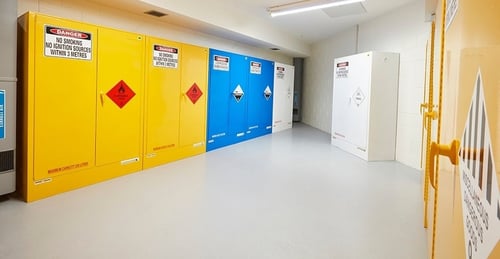
A compliant cabinet is powder coated in a specific paint colour to make it easy to identify which chemical class is being stored in that cabinet.
It’s vital that you select the correct cabinet for the class of chemicals that you’ll be storing in order to reduce risk. Without the specific features of a compliant cabinet, your goods won’t be adequately protected from incidents such as spillage, hazardous vapour emissions, impact damage, fire or heat.
Once you’ve selected your cabinet, you’ll also have to think about the rules of chemical segregation. Make sure that you have read the Safety Data Sheet for every chemical product that you’re storing and segregated chemical classes from one another. Never placed mixed classes of chemicals within the one cabinet, as this could cause the release of harmful gases or even a dangerous chemical reaction.
We recommend purchasing separate chemical cabinets for each class of chemical, so the cabinet provides the dangerous goods segregation necessary for safe storage.
IMPORTANT: While your cabinet offers protection against dangerous chemical reactions and incompatible substances, once the doors of your cabinet are open, hazardous vapours and liquids could potentially escape or leak from your chemical packages. To avoid the risk of chemical reactions, make sure that cabinets storing incompatible substances are never accessed at the same time. Alternatively, keep a safe distance between your safety cabinets to ensure that incompatible substances are properly segregated during chemical handling tasks.
4. Will It Need Mechanical Ventilation?
When storing hazardous chemicals in an indoor environment, you must consider if your cabinet may require mechanical ventilation.
Mechanical ventilation may be a necessary requirement for particular classes of dangerous goods —or it may be required due to unsafe concentrations of airborne contaminants in the breathing space of workers.
Therefore, when you’re considering the purchase of a safety cabinet, also consider if mechanical ventilation of your equipment is required. Chemical cabinets are constructed with features (flash arrestors and vents) that allow for the installation of a compliant mechanical ventilation system.
However, make sure that you enlist the help of a qualified engineer who can construct and install the ventilation system — without undermining the risk controls of the cabinet itself.
REMEMBER: You’re obliged under Australian Work Health and Safety Regulations (2021) to not only monitor but manage the hazardous vapour emissions associated with chemical handling and storage. To minimise the risk of human harm, you must adhere to the legal limits outlined in the workplace exposure standards and actively reduce high concentrations of vapours by either the reduction of chemicals stored, improvements in housekeeping methods, and/or the installation of mechanical ventilation.
5. Will It Be Suitable In 5 Years’ Time?
Buying a chemical storage cabinet is an investment in the health and safety of your staff and your operations. When selecting a cabinet for your workplace, you should ask yourself if the equipment will be sufficient to house the chemicals that you’ll be storing in 5 or even 10 years’ time.
While none of us have a crystal ball to see the future of our business, a little forward planning can help you save money on dangerous goods storage equipment.
Generally, larger capacity chemical cabinets offer greater value for money per litre of storage. So, while purchasing a smaller cabinet may seem like a good idea at the time, it will turn out more costly in the long run if you need to purchase additional chemical storage cabinets — or upgrade your existing cabinet to a larger model.
6. Does It Meet Australian Standards?
Is your cabinet constructed in full conformance with the relevant Australian Standards? This is one of the most crucial factors that should determine your buying process.
The Australian Standards offer in-depth guidance on the handling and storage of all classes of dangerous goods. In relation to safety cabinets, each standard provides the requirements that relate to the construction of the cabinet.
Essential features of a compliant cabinet may include:
- Liquid-tight spill sump that holds a specific capacity of spillage
- Self-closing, tight-fitting doors for spillage and vapour containment
- Double-walled sheet steel construction with thermic air barrier
- Dangerous goods and hazard signage that meet requirements
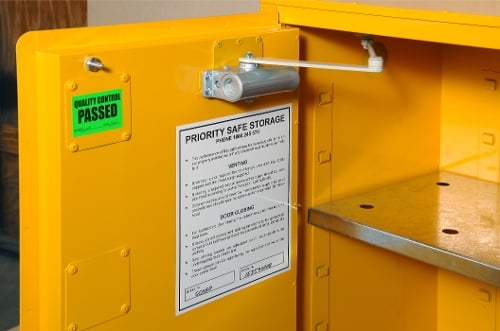
Self-closing, tight-fitting doors are a requirement for Class 3 Flammable Liquids storage cabinets.
While the list of construction requirements for each class of chemical cabinet is extensive, there is a simple way to check that your cabinet meets these Standards. A compliant cabinet should be marked with a label specifying the Australian Standard that it conforms to. You may also request a certificate of conformance to the Australian Standard from your supplier or manufacturer.
Without confirmation that your cabinet meets the necessary safety requirements, you could be at risk of purchasing a cabinet that doesn’t provide adequate risk protection for your business.
7. Do I Need Safety Showers or Eye Wash Stations Installed?
To reduce the risk of human harm in your organisation, you may need to consider the installation of safety showers and eye wash stations near your chemical cabinets. These emergency decontamination facilities must be installed close to hazardous chemical stores in the event that a harmful chemical is splashed or spilled onto staff.
However, the installation of safety showers and eye wash stations is generally dictated by three factors: an onsite risk assessment, WHS Regulations and the relevant Australian Standard. If your organisation determines that you need an eye wash station and/or a safety shower, then it must be installed close to your chemical cabinet. This is so you staff can quickly access the decontamination facilities within 10 seconds of an incident occurring.
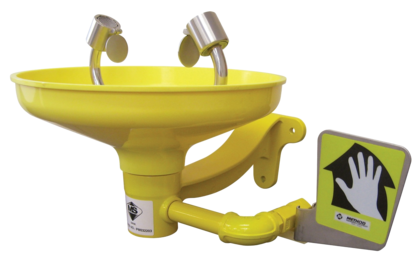
When installing any dangerous goods storage equipment, consider if emergency decontamination equipment is required.
You should always determine the need for emergency decontamination equipment before you purchase and install a chemical storage cabinet in your workplace.
Get It Right, The First Time
We get it. Selecting the right chemical cabinet is a big decision and an important investment in your workplace health and safety. We hope our latest post has helped you on your journey towards creating a safer, compliant workplace with our cabinet selection and installation tips.
If you’d like to learn more about controlling the risks associated with hazardous chemicals and dangerous goods, we have an eBook that may be useful. Controlling Risks Associated With Hazardous Chemicals will introduce you to our failsafe 4-step risk management methodology that you can easily apply to your own workplace. Our eBook will help you understand how you can identify and control chemical risks through our straightforward 4-step process. Grab your copy of our guide today by clicking on the image below.
Joining the team as a Dangerous Goods Storage Consultant, Melissa Hampton became Storemasta's Marketing Manager in late 2021. With extensive knowledge and experience in chemical compliance, Melissa is responsible for leading the Marketing team and helping shape their marketing strategy. In her spare time, you can find Melissa hiking, swimming and enjoying the great outdoors in beautiful north-west Tasmania.
